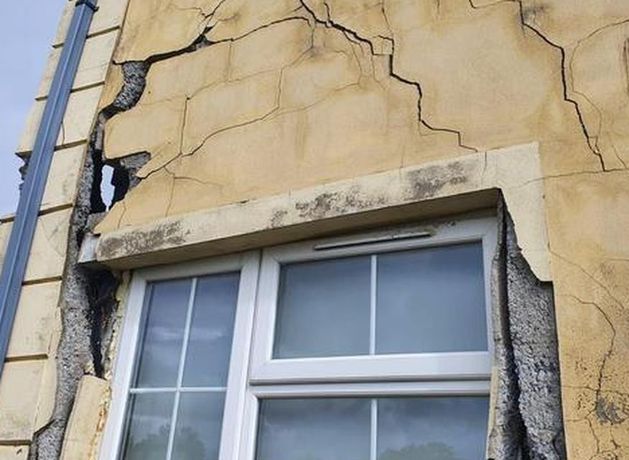World
Homes in at least 16 counties affected by defective concrete as concerns raised over EU safety standard

Experts have warned the defective concrete could appear in more parts of the country.
There is early evidence of defective concrete in Carlow, Wexford, Monaghan, Wicklow and Kerry, according to a report by UK-based minerals consultancy expert Petrolab. Among them is a case where pyrrhotite, the mineral devastating homeowners in Donegal, was found in a “new build” home in another county.
Defective blocks have already caused serious damage to homes in Donegal and other counties
Petrolab principal consultant mineralogist Dr Christopher Brough said the findings need to be given serious consideration.
“In Kerry and Wicklow the occurrences of deleterious concrete block likely relate to transportation of blocks from adjacent counties,” Dr Brough said.
“The concrete block occurrence in Kerry looks exactly the same as that used in Clare and we have assumed for now that it therefore originated from there.
“It is possible similar cases could be repeated in other counties and determining the extent and scale of this should be given consideration,” he added.
Petrolab’s report said there are separate cases in Louth, Meath and Dublin where “deleterious concrete” was found. The company identified cases in at least 13 counties.
Many are counties where homeowners are not able to access redress schemes available for damaged properties in Donegal, Mayo, Clare and Limerick. Sligo was added to the scheme last month.
A survey of Engineers Ireland members earlier this year found they recorded “deleterious materials” and defective concrete blocks in 14 counties including Cavan, Kildare and Kilkenny.
Petrolab’s findings were published in a report assessing a European certification standard for concrete and aggregates. The materials must conform with the certification, known as EN 12620, if used in homes and buildings.
Pyrrhotite is made of iron and sulphur. When it comes into contact with moisture and oxygen it contributes to an internal sulphate attack
The Petrolab study found cases where defective concrete in other parts of the country complies with the standard.
“This calls in to question the EN 12620 value when framboidal pyrite is known to be present and the hosting aggregate is weak, calcareous and prone to reaction,” the researchers said.
Framboidal pyrite reacts in weak aggregate, leading to expansion and cracking.
Homes in Donegal affected by the defective concrete crisis do not meet this certification criteria because of the presence of pyrrhotite, a mineral which causes concrete to crack and crumble.
A separate mineral called pyrite is blamed for the defective concrete in Mayo.
The report found “there are several occurrences in Co Mayo where the aggregate in use is in clear breach” of the European standard, but defective concrete in other counties would comply with it.
Pyrrhotite was also found in two other counties, Petrolab said, without identifying them.
Pyrrhotite is made of iron and sulphur. When it comes into contact with moisture and oxygen it contributes to an internal sulphate attack — where a sulphur expands and causes the concrete to crack. A second phase later sees sulphuric acid attack the concrete, causing it to crumble.
In one case the home affected “was described as a ‘new build’”, the researchers said.
ARCHIVE: 1,500 strong crowd in Donegal sends stern message over defective concrete block scheme
“It is a cause for concern that such sources are still being actively extracted inside current regulations,” they added. This research was carried out on a private basis, Dr Brough said, so some of the affected homes or clients could not be identified.
The company previously worked on state-backed research commissioned to inform Geological Survey Ireland (GSI) and the Government’s understanding of the defective concrete.
The report warned “it is difficult to extrapolate too much” from the cases in Carlow, Wexford, Monaghan, Wicklow and Kerry because they “are typically unique occurrences”, but Dr Brough said the findings are important.
“Our recommendation is that the regulation around aggregate use, particularly within EN 12620, be tightened up to prevent more poor quality aggregate being inadvertently used. One way of tightening this up is to put greater constraints on total sulphur limits,” he added.
“For most Irish counties, outside of Donegal, the aggregate associated with damaged properties that has been used is technically compliant with the EN 12620 standard for total sulphur limit, but is nonetheless often unsuitable for use.”
The European Committee for Standardisation and the European Committee for Electrotechnical Standardisation which develop European standards did not respond to questions last week.
The Petrolab report is not the first time questions have been asked of certification standards and how they are applied to concrete used in defective homes.
Engineers Ireland has said the State’s redress scheme is not fit for purpose because a technical standard, published by the National Standards Authority of Ireland (NSAI) and used by engineers to test damaged houses, is outdated.
Concrete in relevant counties cannot be checked for pyrrhotite until this standard is revised.
The Department of Housing has said the NSAI is working on drafting interim guidance to “enhance the sampling and testing protocols” for affected homes so pyrrhotite can be considered.










